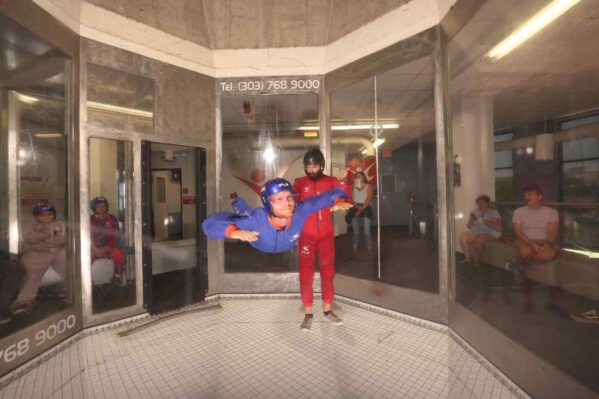Features, New Flyers
My First Time Indoor Skydiving
If you’ve ever wanted to go skydiving, go indoors first. Here’s why.

[the_ad_placement id=”article-above-content-mobile-only”]
I’m a novice. I have no qualms about admitting it. Until I began writing for Indoor Skydiving Source, I had never actually been in a wind tunnel myself. I have extensive experience writing for the action sports industry, covering everything from rock climbing to whitewater kayaking to mountain biking to mountaineering, but I’ve never had anything to do with skydiving, until now.
Why? Well, it’s not that it didn’t interest me. If I’m being honest, I’d say that it’s because I was burdened with the same misconceptions that many may have about the sport.
Mainly, I thought indoor skydiving was expensive and that it served no purpose if one wanted to go outdoor skydiving (it turns out, both of these preconceptions couldn’t be further from the truth).
Of course, writing for Indoor Skydiving Source meant I needed to get up to speed. So last week, I went to iFLY Denver and did my first few flights in their 12-foot (3.7 m) recirculating tunnel. If you’re like I was and you’ve never gone indoor skydiving either, I think you’ll benefit from reading how my first experience in a wind tunnel went down. These are my thoughts, fresh from the mind of a wind tunnel newbie.
For starters, in some respects being a novice has been a beneficial experience. I’m experiencing the sport as a first-timer would, with no prior bias or prejudice. I had no idea what to expect.
In short, being in a wind tunnel feels like you’re floating in the air (which… you are). It’s thrilling, but not scary in any way. I felt safe the entire time. They keep an instructor by your side, guiding you so you don’t spiral out of control.
Like most adventure sports, there is a learning curve. Your first time in a wind tunnel is much like the first time paddling out on a surfboard, stepping off a ski lift, hopping on a slackline, or tying in for a rock climb. You’re more concerned with staying in control of yourself than you are attempting any exciting movements.
More than anything, perhaps, I was concerned with not making a fool of myself in front of my girlfriend, who was standing outside the tunnel taking rapid-fire pictures like a mom at her kid’s high school graduation. Soon enough though, I loosened up and started enjoying it.
Quickly I came to realize that indoor skydiving is like a colorful cousin of gymnastics at its purest.
You can flip, you can spin, you can… well, you can fly. There’s nothing holding you back. There’s nothing you can’t do, no shape you can’t achieve, no form you can’t reach, with the power of the wind tunnel keeping you aloft.
It’s your body and air. That’s it. Nothing more.
As I mentioned, there’s a significant learning curve. I and the other first-timers mostly spent our time in the wind tunnel floating in stasis, rotating in the column of air as we learned to control our bodies. It will definitely be some time before I’m able to do exotic tricks in the tunnel.
That said, I saw firsthand evidence that the possibilities for acrobatics and movement in wind tunnels are limitless. Before and after our group went into the wind tunnel, the iFLY instructors hopped in to demonstrate their skill, twirling and flipping and rocketing through the air at breakneck speeds. Quite literally it looked like a superhero was flying around the room. I felt as though I was watching a Cirque du Soleil show from two feet away, in broad daylight, with no wires or costumes.
These people were flying, plain and simple.
More than anything, my experience at iFLY taught me just how much coordination and body control it takes to stay in control when in freefall. Being in a wind tunnel, you’ll experience a similar wind speed to that which you’ll experience jumping out of a plane. I’ve always wanted to go traditional skydiving, but I never thought about how much body control would play a role in that experience. When I saw images or videos of people in freefall, situated in the classic “skydiver” pose, I figured that was just the natural pose you get into when you fall.
Well… it’s not. Keeping proper form under high winds takes practice and effort. At one point, I tilted my palms slightly, and the resulting misdirection of wind sent me spinning out of control to the side (luckily, my instructor caught me). Even after my handful of flights, I still had a lot to learn, and I’m now determined to train more before getting into traditional skydiving.
Traditional skydiving is accessible to newbies, of course (if you want to go tandem), but it’s quite expensive, not to mention the detrimental effect plane flights have on the environment. It’s also an extremely brief experience, with most freefalls lasting less than a minute, if that.
Simply put, you don’t have a ton of time to screw around.
So, when you pay for a skydive and hop in that plane, you want to make your jump count.
That’s precisely why before I attempt any jumps outside, whether tandem or after taking time to train and jump solo (the latter, preferably), I want to spend more time in a wind tunnel.
If you’ve ever aspired to BASE jump or skydive outside, pay your $40 and hop in a wind tunnel first. You’ll know what it feels like to free fall, you’ll know how to control your body, and your experience in true free fall will be astronomically more enjoyable (and safe) because of it.
All told, wind tunnels like iFLY offer something for everyone. They offer a safe, accessible, and affordable way for younger children and newbies to learn the sport, and they offer the pros a controlled environment in which to train.
Whether you want to someday learn to skydive or BASE jump, or you simply are looking for an affordable, unique activity to relax on a rainy afternoon… Check out a wind tunnel near you!
I guarantee you’ll be glad you did.
Published: September 3, 2021 | Last Updated: September 3, 2021
Don’t miss an update!
Join our mailing list for the latest indoor skydiving updates delivered directly to your inbox.
"*" indicates required fields

